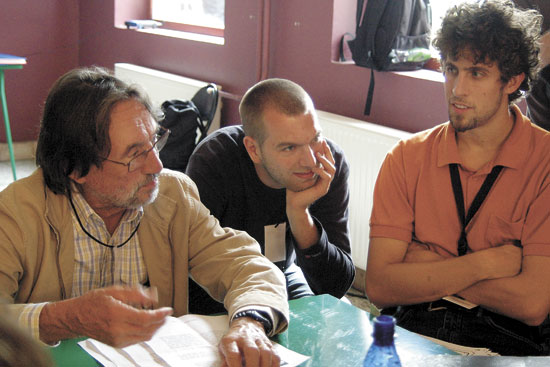Riding down the rapids of the Chattooga River in a raft while clutching a handheld, underwater camera during the filming of the 1972 film “Deliverance,” cinematographer Vilmos Zsigmond was not thinking about the threat of crashing into the rocks at any given moment. He was thinking about getting the shot.
Perhaps this wasn’t the safest or most traditional way to get the job done, but it was the only way. Then again, not much about Zsigmond’s life journey is safe or traditional.
Named this quarter’s Kodak Cinematographer-in-Residence at the UCLA School of Theater, Film and Television, Zsigmond will conduct a series of cinematography workshops with film students.
He will also take part in a discussion about his work on the 1971 film “McCabe & Mrs. Miller,” one of the few films to be called “perfect” by Roger Ebert, following a screening of the movie tonight at the James Bridges Theater. Gail Duncan, the account manager for students in California at Eastman Kodak, the company that organizes the residency program, said she hopes UCLA students take advantage of what Zsigmond has to offer.
“(He) has got the breadth of experience, not only behind the camera, but life experience itself,” Duncan said.
That life experience started in Szeged, Hungary. At the age of 17, Zsigmond developed a kidney infection that required him to stay in bed for about three months.
“(My uncle) gave me this book to read (on black and white photography) since I was bored, and it was so inspiring to me,” he said.
As Zsigmond’s interest in photography grew, so did the political turmoil in 1950s Hungary.
With limited academic options because of his family’s affluence, Zsigmond traded in photography when he was invited to study cinematography in Budapest.
After graduation, his homeland was still in danger, so Zsigmond and good friend and fellow cinematographer László Kovács took it upon themselves to put their degrees to work and document the Russian occupation of Hungary.
“We basically shot the destruction, what the Russians did in the street,” Zsigmond said.
“If they caught you, they would kill you right on the spot, probably. So we were shooting from broken windows where they could not see us.”
Risking his life again, Zsigmond fled to the United States with the smuggled footage, which he and Kovács sold to CBS.
Afraid to return home, Zsigmond worked his way to Hollywood picking up English and experience on low-budget films along the way.
Today, Zsigmond has more than 75 feature films under his belt. He has numerous award nominations and wins, including multiple lifetime achievement awards and even an Oscar for best cinematography for his work on Steven Spielberg’s “Close Encounters of the Third Kind.”
Zsigmond still claims he prefers low-budget projects.
“You don’t need $20 million to make a movie,” Zsigmond said. “Low-budget (films are) more creative because you have to fight to get the quality of the picture. … I like to do movies which are visually interesting, and it says something to the people that watch it.”
UCLA Professor William McDonald said he invited Zsigmond to be the 10th resident of the program because he felt Zsigmond, too, says something to the people that watch him.
McDonald is the head of the cinematography department within the School of Theater, Film and Television and the founder of the Kodak Cinematographer-in-Residence program.
“He is passionate, and the idea of passion is that it infuses everything he does, whether it’s how he lit a scene, how he lives his life or how he connects with his students,” McDonald said.
While this residency marks Zsigmond’s first time teaching at UCLA, it is hardly his first venture into academia.
He and Kovács started the biannual Budapest Masterclass for cinematography almost 30 years ago for international students. Despite this long commitment, Zsigmond still encounters some challenges in the classroom.
“The difficult part is always … where I talk about how to light a scene, how to create a mood and what is important in cinematography,” Zsigmond said. “You cannot give (students) a formula. I can only give them attitude and approach.”
Christopher Carroll, a third-year graduate student in the cinematography program, can already anticipate what he’ll learn from Zsigmond.
“When you’re in a situation where what you thought was going to work isn’t quite working, you have to find a way to one, make it look like you’re not scared and two, find the quickest and easiest way to make it work,” Carroll said.
“I think that’s a big thing to take from someone like him who’s spent so many years doing that.”
When Zsigmond isn’t riding down a river or trying to get the shot, he’s thinking about the future of cinematography in an increasingly digital world.
“I’m teaching all the time because I feel I have the responsibility to pass on my knowledge, my experience to younger people,” Zsigmond said.
“I want to teach everything that I know so they will know that there is such a thing as good lighting, good composition, good filmmaking.”
